Are you pushing yourself to the limit in your workouts, but still not seeing the gains you expect?
I know the feeling. For a long time, I thought that more reps, heavier weights, or longer sessions were the key to better performance.
However, I discovered that the real secret lies in something we often overlook – breathing.

That’s when I began to delve into the world of breathing techniques for enhanced performance, and it completely transformed my approach to fitness.
In this blog, I want to share my personal journey, the valuable lessons I’ve learned, and the products that I have found to be invaluable for improving my breathing during workouts.
This is my journey and I hope you can learn something from it.
Why Proper Breathing is Essential for Enhanced Workout Performance
So, why is breathing so crucial for a great workout? It all boils down to basic physiology.
Our muscles require oxygen to function efficiently and produce energy.
When we exercise, our muscles demand even more oxygen.
This is where our breathing comes in. Think of each breath as fuel for your muscles.
Proper breathing ensures that your muscles are receiving adequate oxygen to perform at their best.
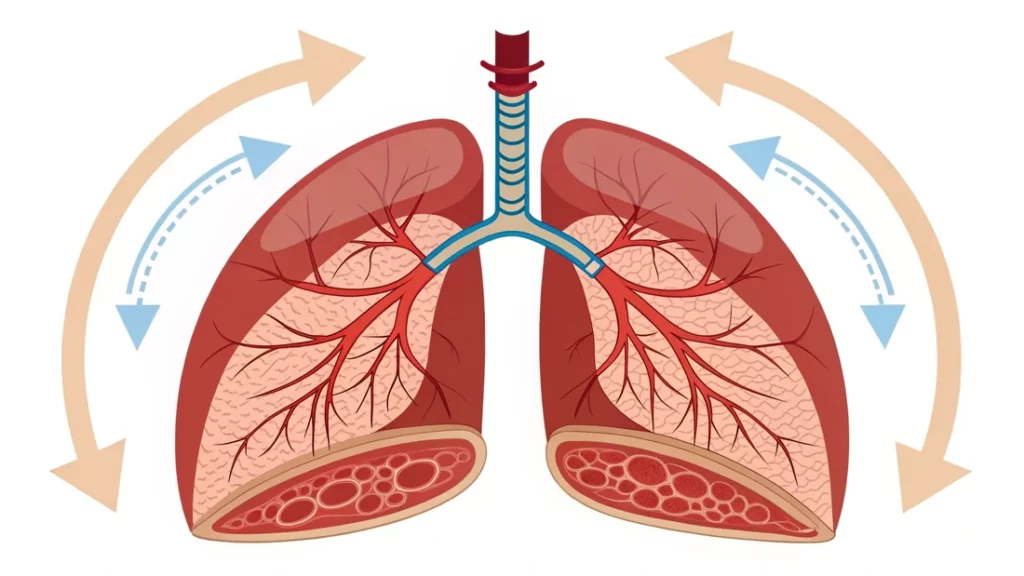
The process works like this: when you breathe in, oxygen travels from your lungs into your bloodstream.
Your bloodstream then carries the oxygen to your muscles, which use it to create energy, allowing you to push harder for longer.
Unfortunately, many athletes and fitness enthusiasts make common breathing mistakes that can hinder their performance.
Often, we might hold our breath during strenuous activity, breathe too shallowly, or even breathe too fast.
These mistakes can have a number of negative effects.
For example, holding your breath prevents oxygen from reaching your muscles, which can cause them to tire more quickly.
Shallow breathing doesn’t fully utilize the lungs’ capacity and may cause you to become short of breath more easily.
Fast breathing often makes us breathe with our chest instead of our diaphragm, and this causes tension and less oxygen to be delivered.
By being mindful of these errors and learning proper breathing techniques, you can help to improve your workout experience dramatically.
My Personal Journey – Discovering the Power of Breathwork
Like many others, I used to approach workouts with a ‘no pain, no gain’ mentality.
I would push myself as hard as I could, often ignoring my body’s signals, especially the way I was breathing.
This method left me feeling exhausted and frustrated. I knew that I needed a change.
That is when I started my personal journey into the world of breathwork, specifically in relation to exercise.
I was skeptical at first, but after reading about the science behind breathing, I became intrigued and decided to experiment with it.
I had heard that breathwork could help improve performance and help with recovery, so I decided to give it a go.
That is when I learned that proper breathing was not just about taking air in, but also about consciously controlling my breath to enhance every aspect of my workout.
The first time I truly noticed a difference was during one of my intense HIIT workouts.
I started applying paced breathing and found that I could push myself harder for longer, without the usual feeling of being out of breath.
It was honestly a game-changer. I then tried diaphragmatic breathing, and noticed I was able to control my body so much more and feel less tense during weightlifting.
I also implemented breathwork into my recovery days, and noticed a reduction in soreness and felt more relaxed than before.
It was from that point on that I fully embraced the importance of mindful breathing and started to explore different techniques and strategies.
Effective Breathing Techniques to Enhance Your Workouts
Now, let’s get into the specific breathing techniques that I have found to be truly transformational in my own training journey.
These aren’t just random exercises; they are practical methods I’ve incorporated into my routine to achieve tangible improvements.
Each technique is designed for specific needs and provides its own set of unique benefits.
Let’s delve into the ‘how-to’ of each of these, and explore how you can integrate them into your workouts.”
Diaphragmatic Breathing (Belly Breathing) for Improved Stamina
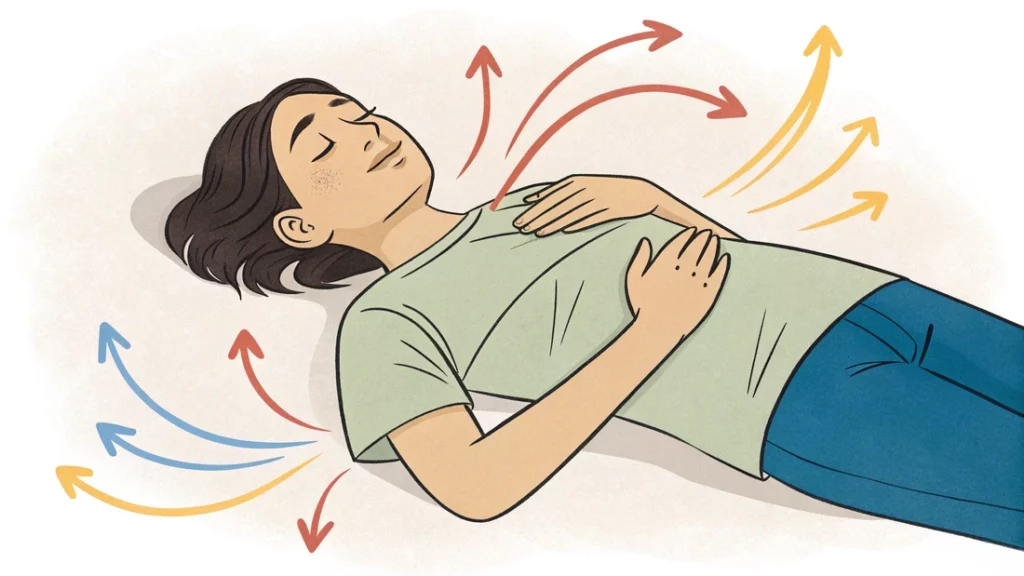
- Diaphragmatic Breathing:
- Diaphragmatic breathing, also known as belly breathing, focuses on utilizing the diaphragm, which is a large muscle at the base of your lungs, rather than relying on shallow chest breathing.
- It’s a powerful method for ensuring optimal oxygen flow and promoting relaxation during intense workouts.
- How to do it (step-by-step):
- Find a comfortable position: Lie on your back, sit upright, or stand.
- Place one hand on your chest and the other on your belly: This allows you to feel the movement during this exercise.
- Inhale slowly through your nose: As you inhale, allow your belly to rise while keeping your chest relatively still.
- Hold for a moment: Pause briefly to allow the oxygen to circulate in your system.
- Exhale slowly through your mouth: Allow your belly to draw in as your chest and lungs deflate.
- Repeat: Continue this practice for a few minutes, or as needed during your workout.
- Benefits for workouts:
- Diaphragmatic breathing helps to maximize your lung capacity, ensuring your muscles receive a consistent flow of oxygen, which can help to dramatically improve stamina. I find this breathing technique particularly helpful when performing longer, endurance-based activities like long runs, hiking or swimming.
- My personal experience:
- I noticed a remarkable difference during my long runs after implementing this technique. Before, I would feel breathless and fatigued, but now I can sustain my energy levels for longer with a better lung capacity and performance. I find it helps me feel more grounded and less strained.
Paced Breathing (Rhythmic Breathing) for Energy Management

- Paced Breathing:
- Paced breathing, or rhythmic breathing, involves coordinating your breath with your movements during exercise. This technique helps to conserve energy and maintain a steady pace, especially in activities like running, cycling, or weightlifting.
- How to do it (step-by-step):
- Start with a comfortable rhythm: Align your breath with your steps, repetitions, or movements.
- Inhale for a specific number of steps/reps: For example, inhale for 2 steps if you are running or 2 repetitions if you are doing weightlifting.
- Exhale for a specific number of steps/reps: Mirror the number of steps or reps you took on the inhale.
- Adjust your pattern as needed: It can take some time to get used to this breathing pattern, but overtime it will become second nature.
- Practice: Start with a simple pattern and gradually adjust as your fitness level improves.
- Benefits for workouts:
- Paced breathing helps you to conserve energy and maintain a steady pace by ensuring that your body receives the oxygen it needs and when it needs it, reducing any stress you may feel. I find this especially helpful with high intensity exercise like weightlifting or HIIT training.
- My personal experience:
- I can’t explain how big of a game changer this was! I have noticed that when I integrate paced breathing into my weightlifting routines I am able to feel more focused, less strained, and I am able to perform more repetitions before I get to the point of failure.
Box Breathing for Focus and Performance
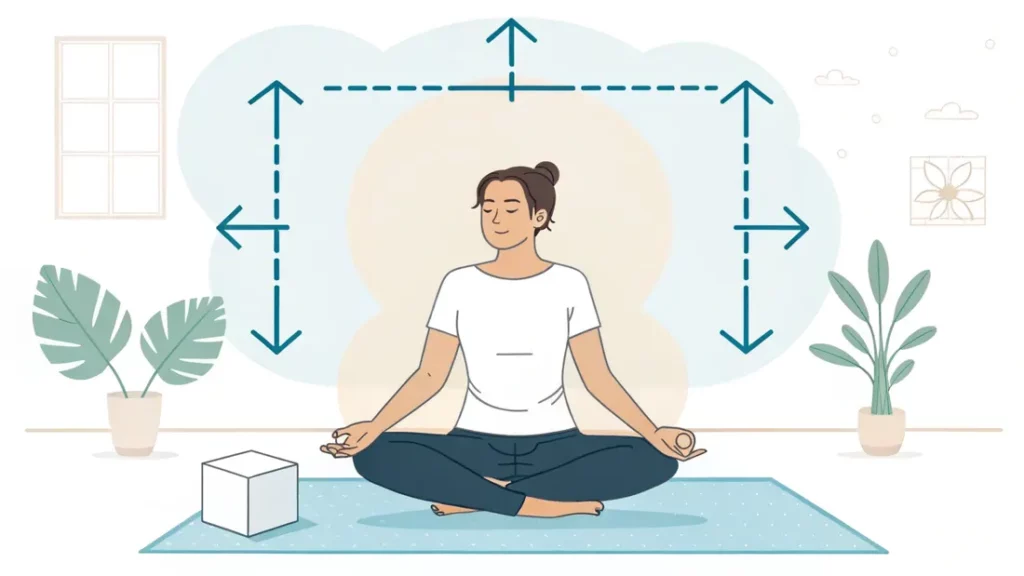
- Box Breathing:
- Box breathing is a powerful technique that promotes both mental clarity and physical control, making it great for focus and workout performance. The method helps to calm the mind and promotes overall well-being.
- How to do it (step-by-step):
- Inhale Slowly: Inhale deeply through your nose for a count of four.
- Hold: Hold your breath at the top of your inhale for a count of four.
- Exhale Slowly: Exhale gently through your mouth for a count of four.
- Hold: Hold your breath after your exhale for a count of four.
- Repeat: Continue this cycle for a few minutes, or as needed during your workout.
- Benefits for workouts:
- Box breathing is an effective technique for creating focus and calm in workouts by slowing down your heart rate and reducing feelings of stress.
- My personal experience:
- I used to struggle to calm my thoughts during workouts. With box breathing, I noticed a major difference! Not only am I less stressed, but I also feel more in control of my movements which, for me, has lead to a boost in performance. This is especially great before or after intense exercise when I may feel more stressed and tense.
Recommended Products for Improving Your Breathing During Workouts
Throughout my journey, I have found that using specific tools and equipment has further improved my breathing techniques.
Although these tools are not necessary, they have helped me to monitor my breathing, take my breathing techniques further, and create further awareness in my overall fitness journey.
If you are interested in further supporting your breathing workout goals, I highly recommend these products that I have personally used and loved.
Breathing Trainer
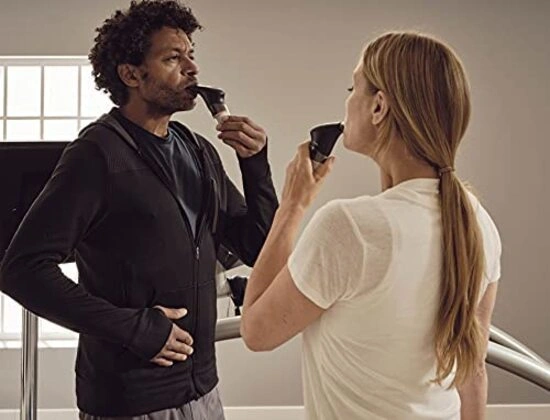
- Description:
- A breathing trainer is a device designed to improve your respiratory muscles by making them work harder.
- It helps to improve your lung capacity and strengthen your diaphragm, thereby promoting more efficient breathing.
- My personal recommendation is the POWERbreathe Kinetic, but there are many others on the market.
- You should choose the one that fits your personal needs and budget.
- Personal Experience:
- I’ve found using a breathing trainer to be incredibly beneficial.
- At first, it felt very odd, but after a couple of weeks, I noticed my breathing had improved during my workouts and I could perform them more effectively.
- I started integrating my breathing trainer into my workout warmup routines, and this has given me the ability to improve my lung capacity and breath control, which is something that I had struggled with before.
- Explore the Powerbreathe Kinetic Breathing Trainer on Amazon
Fitness Tracker with Breathing Analysis
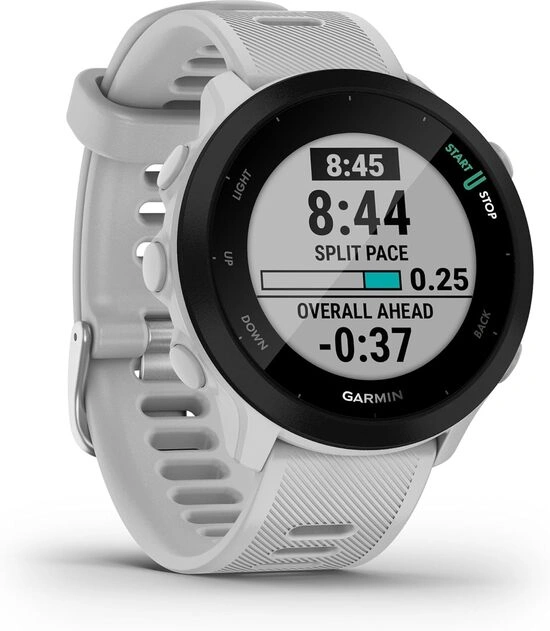
- Description:
- A fitness tracker that offers breathing analysis can provide you with real-time feedback on your breathing patterns during workouts.
- Many fitness trackers measure heart rate variability, respiratory rate, and other factors that can give you insights into the effectiveness of your breathing.
- The Garmin Forerunner has been my go-to fitness tracker as it offers amazing tools for measuring your overall workout performance, but there are many great fitness trackers on the market that can provide you with similar results.
- Personal Experience:
- Using a fitness tracker has allowed me to track my breathing patterns to help me monitor my progress.
- I’ve used it during various workout sessions, and it’s great to see how my breathing improves.
- With features like heart rate variability and breathing rate tracking, it has become invaluable in helping me to understand how my body performs during various exercises, and how I can make further improvements.
- Check out the Garmin Forerunner on Amazon
Practical Tips for Getting Started
Embarking on a new fitness routine, especially one focused on breathing, can seem overwhelming, but I can tell you that it doesn’t have to be.
Here are some practical tips that I found helpful in my journey, and I hope they will guide you in yours.
Remember that the goal here is to improve your workout experience, not to rush the process.
Be patient with yourself and your body, and know that practice makes perfect.
Let’s begin:
Practical Tips
- Start Slowly:
- Take a gentle approach when starting with new breathing techniques.
- Do not rush or try to do too much too soon.
- Start practicing in a quiet space to focus on your body and breath.
- Begin with a few minutes of daily practice.
- Gradually increase practice time as you become more confident and comfortable.
- For example, try diaphragmatic breathing a few times daily.
- Be patient and focus on developing a mindful breathing habit for your daily life.
- Consistency is Key:
- Remember that consistency is crucial for achieving long-term results.
- You don’t need to practice for hours, but consistency is key.
- Incorporate exercises into your daily workouts or activities you enjoy.
- Consistent practice will have a compound effect, improving overall performance and well-being.
- Listen to Your Body:
- Always listen to your body and how you are feeling.
- Know your limits and do not push too hard.
- If you feel lightheaded, uncomfortable, or dizzy, stop immediately.
- Adjust the methods to suit your specific needs, and do not force yourself into a method that is not working for you.
- Find a perfect balance that works for your body and fitness levels.
- Be mindful and patient, and let your body guide your progress.
My Final Thoughts on Breathing for Better Workouts
So, as we reach the end of this journey, I hope you’ve gained a new perspective on the power of proper breathing for better workout performance.
It’s so much more than just inhaling and exhaling. It’s about mindfully connecting with your body, controlling your breath, and using it to maximize your potential.
By incorporating breathing techniques like diaphragmatic breathing, paced breathing, and box breathing, you can see drastic improvements in your stamina, energy management, and mental focus, while also speeding up recovery time.
And remember, the products I’ve recommended have proven to be very helpful for me, so they may be helpful for you too.
I hope that this blog will serve as a stepping stone for your own exploration into the world of breathing.”
I encourage you to start experimenting with these methods in your own routine and see just how big of a difference that proper breathing can make in your performance.
Take some time to make mindful breathing a part of your lifestyle, both in and out of the gym.
You might be surprised at the difference that can be made when you focus on your breath.
Thank you for taking the time to join me on this journey!
Now go forth and breathe!”
Related Posts



